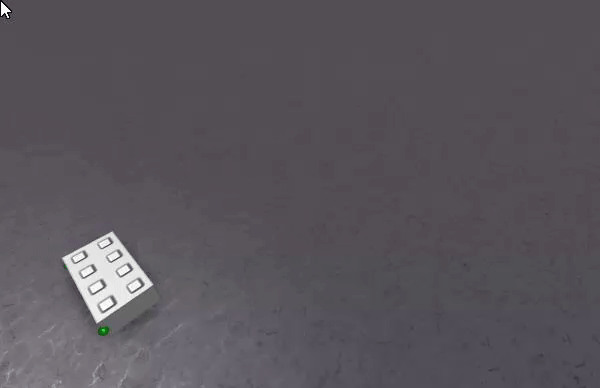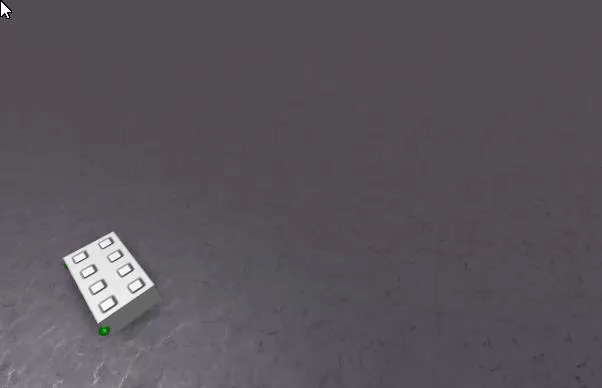
Type Index Pages
- BillboardGui
- CanvasGroup
- Frame
- Hint
- ImageButton
- ImageLabel
- PlayerGui
- ScreenGui
- ScrollingFrame
- StarterGui
- SurfaceGui
- TextBox
- TextButton
- TextLabel
- UIAspectRatioConstraint
- UIGradient
- UIGridLayout
- UIListLayout
- UIPadding
- UIPageLayout
- UIScale
- UISizeConstraint
- UITableLayout
- UITextSizeConstraint
- VideoFrame
- ViewportFrame
- ChangeHistoryService
- CoreGui
- DataModelSession
- DockWidgetPluginGui
- MultipleDocumentInterfaceInstance
- Plugin
- PluginAction
- PluginGui
- PluginGuiService
- PluginManager
- PluginMenu
- PluginMouse
- PluginToolbar
- PluginToolbarButton
- QWidgetPluginGui
- Selection
- StandalonePluginScripts
- StatsItem
- StudioService
- StudioTheme
No results found!
-
Instance
- GameSettings
- DebugSettings
- BodyMover
- WeldConstraint
- HttpRbxApiService
- NotificationService
- Translator
- Lighting
- Beam
- GuiService
- UserInputService
- Studio
- Plugin
- HttpService
- Mouse
- BindableEvent
- RunService
- Pages
- Humanoid
- TestService
- PathfindingService
- Chat
- NetworkPeer
- Feature
- CharacterAppearance
- Constraint
- NetworkReplicator
- JointInstance
- Light
- BasePlayerGui
- AnalyticsService
- NetworkMarker
- BinaryStringValue
- FlyweightService
- Geometry
- LoginService
- InstancePacketCache
- ThirdPartyUserService
- TouchInputService
- RuntimeScriptService
- GuidRegistryService
- PartOperationAsset
- DialogChoice
- PhysicsService
- AdService
- TextService
- MarketplaceService
- TeleportService
- Accoutrement
- GamePassService
- AssetService
- InsertService
- PointsService
- ChangeHistoryService
- ServerScriptService
- JointsService
- LogService
- InputObject
- Toolbar
- LuaSettings
- RenderSettings
- AnimationTrack
- PhysicsSettings
- NetworkSettings
- CFrameValue
- Animation
- Color3Value
- BoolValue
- BrickColorValue
- Vector3Value
- AnimationController
- BindableFunction
- Button
- Trail
- LocalizationTable
- LocalizationService
- DebuggerBreakpoint
- DebuggerWatch
- ScriptDebugger
- Animator
- Attachment
- RemoteFunction
- RemoteEvent
- PluginManager
- Camera
- Stats
- Sky
- StarterPlayer
- Dragger
- TerrainRegion
- Path
- TextFilterResult
- Dialog
- StatsItem
- GoogleAnalyticsConfiguration
- ScriptContext
- ControllerService
- CacheableContentProvider
- ReflectionMetadataClasses
- ReflectionMetadataEnums
- DebuggerManager
- GuiBase
- UIBase
- LuaSourceContainer
- GuiItem
- DataModelMesh
- ServiceProvider
- ReflectionMetadataItem
- PostEffect
- PhysicsPacketCache
- TouchTransmitter
- RobloxReplicatedStorage
- Visit
- LuaWebService
- ScriptService
- FlagStandService
- VirtualUser
- SpawnerService
- TimerService
- CookiesService
- Team
- GroupService
- StarterGear
- Message
- PlayerScripts
- Configuration
- ContentProvider
- CollectionService
- Debris
- ReplicatedFirst
- ServerStorage
- ReplicatedStorage
- Folder
- TweenService
- Players
- ContextActionService
- StarterPlayerScripts
- SoundService
- KeyframeSequenceProvider
- VRService
- PluginGuiService
- Player
- Teams
- Pose
- Keyframe
- KeyframeSequence
- IntConstrainedValue
- DoubleConstrainedValue
- ForceField
- RayValue
- Fire
- Smoke
- Sparkles
- ParticleEmitter
- IntValue
- StringValue
- NumberValue
- Explosion
- ObjectValue
- SoundGroup
- UserGameSettings
- ClickDetector
- Sound
- Selection
- BadgeService
- TaskScheduler
- GlobalDataStore
- DataStoreService
- CustomEvent
- CustomEventReceiver
- VirtualInputManager
- FunctionalTest
- TweenBase
- SoundEffect
- ReflectionMetadataEvents
- ClusterPacketCache
- PVInstance
- FaceInstance
- Controller
- ReflectionMetadataCallbacks
- ReflectionMetadataFunctions
- ReflectionMetadataYieldFunctions
- ReflectionMetadataProperties
- ReflectionMetadata
- AdvancedDragger
- HapticService
- FriendService
- GamepadService
No Result Found !!!
Transparency
The Transparency property of a Trail sets how transparent the segments of the trail are over the trail’s Trail/Lifetime. This value is a DataType/NumberSequence, meaning it can be a static value or can change throughout the lifetime of the trail segments.
The values in the NumberSequence can be any number, but the effective range of transparency is 0 (completely opaque) to 1 (completely see-through). The Transparency property for TrailEffects defaults to 0.5.
Code Samples
Playing in Third Person
This example demonstrates how to change the character’s CameraMode to third person using the Classic value of the Enum/CameraMode enum.
local player = game.Players.LocalPlayer player.CameraMode = Enum.CameraMode.Classic
Setting a Trail's Transparency: Single Value Sequence
This example demos setting the transparency of a trail using a single value sequence DataType/NumberSequence.
In order to do this, we must first create a BasePart, part, which will be the parent of the trail.
Then, we create two attachments, attachment0 and attachment1, both parented to part. The positions of these two attachments, more importantly the distance between them, determines where the trail is drawn as part moves.
For these attachments to create a trail as described, we create a new Trail and parent it to part. We then connect attachment0 to Trail/Attachment0 and attachment1 to Trail/Attachment1.
In this example, we set the trail’s transparency to 0.8 using a single value sequence, which means that the transparency of the drawn segments is linear and constant.
Finally, to demo the transparency the example relies on TweenService’s TweenService/Create to move part back and forth. As the part moves, the trail is drawn.

-- Create a new BasePart
local part = Instance.new("Part")
part.Parent = game.Workspace
part.Anchored = true
part.Position = Vector3.new(0,5,0)
-- Create 2 attachments
local attachment0 = Instance.new("Attachment")
attachment0.Name = "Attachment0"
attachment0.Parent = part
attachment0.Position = Vector3.new(-2,0,0)
local attachment1 = Instance.new("Attachment")
attachment1.Name = "Attachment1"
attachment1.Parent = part
attachment1.Position = Vector3.new(2,0,0)
-- Create a new Trail
local trail = Instance.new("Trail")
trail.Parent = part
trail.Attachment0 = attachment0
trail.Attachment1 = attachment1
local singleValueSequence = NumberSequence.new(0.8)
trail.Transparency = singleValueSequence
-- Tween part to display trail
local TweenService = game:GetService("TweenService")
local dir = 15
while true do
dir = dir*-1
local goal = {}
goal.Position = part.Position + Vector3.new(0,0,dir)
local tweenInfo = TweenInfo.new(5)
local tween = TweenService:Create(part, tweenInfo, goal)
tween:Play()
wait(5)
end
Setting a Trail's Transparency: Multi Value Sequence
This example demos setting the transparency of a trail using a multi value sequence DataType/NumberSequence.
In order to do this, we must first create a BasePart, part, which will be the parent of the trail.
Then, we create two attachments, attachment0 and attachment1, both parented to part. The positions of these two attachments, more importantly the distance between them, determines where the trail is drawn as part moves.
For these attachments to create a trail as described, we create a new Trail and parent it to part. We then connect attachment0 to Trail/Attachment0 and attachment1 to Trail/Attachment1.
In this example, we set the trail’s transparency to a multi value gradient using a multi value sequence. This means that the transparency of the drawn segments is a gradient consisting of a variety of transparencies, each equally spaced out along the trail’s existing segments according to the order of the transparency value in the keypoints array.
Finally, to demo the transparency the example relies on TweenService’s TweenService/Create to move part back and forth. As the part moves, the trail is drawn.

-- Create a new BasePart
local part = Instance.new("Part")
part.Parent = game.Workspace
part.Anchored = true
part.Position = Vector3.new(0,5,0)
-- Create 2 attachments
local attachment0 = Instance.new("Attachment")
attachment0.Name = "Attachment0"
attachment0.Parent = part
attachment0.Position = Vector3.new(-2,0,0)
local attachment1 = Instance.new("Attachment")
attachment1.Name = "Attachment1"
attachment1.Parent = part
attachment1.Position = Vector3.new(2,0,0)
-- Create a new Trail
local trail = Instance.new("Trail")
trail.Parent = part
trail.Attachment0 = attachment0
trail.Attachment1 = attachment1
-- Set the trail transparency using a multi value sequence
local keypoints = {}
table.insert(keypoints, NumberSequenceKeypoint.new(0, 1))
table.insert(keypoints, NumberSequenceKeypoint.new(0.25, 0))
table.insert(keypoints, NumberSequenceKeypoint.new(1, 1))
local multiValueSequence = NumberSequence.new(keypoints)
trail.Transparency = multiValueSequence
-- Tween part to display trail
local TweenService = game:GetService("TweenService")
local dir = 15
while true do
dir = dir*-1
local goal = {}
goal.Position = part.Position + Vector3.new(0,0,dir)
local tweenInfo = TweenInfo.new(5)
local tween = TweenService:Create(part, tweenInfo, goal)
tween:Play()
wait(5)
end
How this site use cookies
This Platform uses cookies to offer you a better experience, to personalize content, to provide social media features and to analyse the traffic on our site. For further information, including information on how to prevent or manage the use of cookies on this Platform, please refer to our Privacy and Cookie Policy.